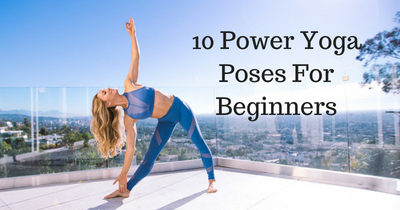10 Power Yoga Poses For Beginners
Disclosure: As an Amazon Associate I earn from qualifying purchases. This page may contain affiliate links, which means I may receive a commission if you click a link and purchase something that I have recommended. There is never an additional cost to you.
Welcome to our blog post “10 Power Yoga Poses For Beginners”
In our sister post “What is Power Yoga and what are the benefits of Power Yoga?” we learnt what Power Yoga is all about. Just as a reminder-
The term Power yoga is quite a general term that is used to describe a vigorous, fitness-based approach to the Vinyasa style of yoga. Many yoga experts consider it to be “gym yoga,” in a style of practice closely modeled on the Ashtanga method.
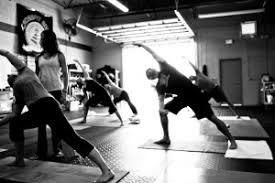
The benefits of Power Yoga were:
- Increases flexibility
- Promotes Stamina
- Promotes weight loss
- Improves Immune system
- Helps Lower cholesterol
- Helps Lower Blood Pressure
- Improves circulation
- Strengthens the body
- Improves posture and balance
So now let’s look at what we consider to be the 10 best Power Yoga Poses and their benefits.
1. Camel Pose (Ustrasana)
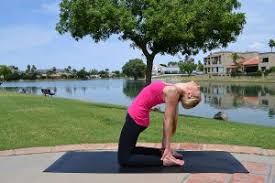
Ustrasana or the Camel Pose is a backbend that resembles the stance of a camel.
Camel Pose — Ustrasana (ooh-STRAHS-uh-nuh) — is performed on the knees and is often used as preparation for deeper backbends. This pose is a popular component of Vinyasa and Power Yoga classes.
It works best when practiced in the morning on an empty stomach and clean bowels. Ustrasana is a beginner level Vinyasa yoga asana.
Its name comes from the Sanskrit words “ustra” (meaning “camel”) and “asana” (meaning “pose”). Practicing Ustrasana daily can be a great way to relieve neck and back pain caused by slouching in front of a computer or driving. One of the best Power Yoga Poses for beginners!
How to do the Camel Pose-
- Begin by kneeling upright with your knees hip-distance apart. Rotate your thighs inward and press your shins and the tops of your feet into the floor. Do not squeeze your buttocks.
- Rest your hands on the back of your pelvis, with your fingers pointing to the floor. Lengthen your tailbone down toward the floor and widen the back of your pelvis.
- Lean back, with your chin slightly tucked toward your chest. Beginners can stay here, keeping their hands on their back pelvis.
- If you are comfortable here, you can take the pose even deeper. Reach back and hold onto each heel. Your palms should rest on your heels with your fingers pointing toward your toes and your thumbs holding the outside of each foot.
- Keep your thighs perpendicular to the floor, with your hips directly over your knees. If it is difficult to grasp your heels without feeling compression in your low back, tuck your toes to elevate your heels. You can also rest your hands on yoga blocks placed to the outside of each foot.
- Lift up through your pelvis, keeping your lower spine long. Turn your arms outward without squeezing your shoulder blades. Keep your head in a neutral position, or allow it to drop back without straining or crunching your neck.
- Hold for 30-60 seconds. To release, bring your hands back to your front hips. Inhale, lead with your heart, and lift your torso by pushing your hips down toward the floor. Your head should come up last. Rest in Child’s Pose (Balasana) or Corpse Pose (Savasana).
Benefits of the Camel Pose are:
- Reduces fat on thighs
- Opens up the hips, stretching deep hip flexors
- Expands the abdominal region, improving digestion and elimination
- Improves posture
- Opens the chest, improving respiration
- Loosens up the vertebrae
- Relieves lower back pain
- Helps to heal and balance the chakras
- Improves flexibility, especially in the spine
- Stimulates endocrine glands
- Releases tension in the ovaries
- Stretches the ankles, thighs, groin, abdomen, chest, and throat
- Tones organs of the abdomen, pelvis, and neck
- Complements overall health and well-being
- Stretches and strengthens the shoulders and back
- Strengthens thighs and arms
- Cures constipation
2. Plank Pose (Chaturanga Dandasana)
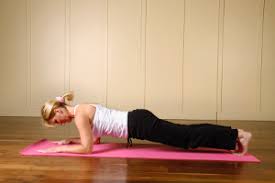
The Plank Pose (Chaturanga Dandasana) is a great Power Yoga Weight Loss exercise as it strengthens and tones your arms,shoulders, back. buttocks,,thighs and abs.
Besides your abdominal, planks strengthen your back, hips and pelvic floor muscles. This exercise greatly improve your posture and help to prevent injuries. Another great Power Yoga Poses that any beginner can practice and control.
How to do the Plank Pose-
- Your arms should be shoulder-width apart and directly below your shoulders.
- Focus on tightening the core muscles and try to make sure your butt stays in line with the body and doesn’t drop down or raise up below your body line.
- Hold for 30 seconds.
- Work towards holding this position for up to 2 minutes.
- Repeat 3 times
Benefits of the Plank Pose are:
- Works and strengthens the entire core.
- Improve your balance and posture.
- It makes your body more flexible.
- Reduce back pain.
- Improves sense of balance.
- Strengthens the arms, belly and legs.
- Stretches the back of the legs.
- Strengthen the spine.
- Improves concentration
3. Downward Facing Dog Pose (Adho Mukha Svanasana)
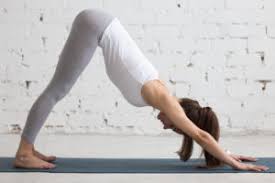
Even if you’ve never attended a yoga class, you most likely have heard of the Downward Facing Dog. It’s one of the easiest Power Yoga Poses for beginners.
However common the pose may be, it’s often assumed and untaught in the yoga studio.
Downward facing dog has many jobs and functions, among them–assessment pose, transitional pose, resting pose, strengthening pose, inversion
How to do the Downward Facing Dog-
- Come down to the floor and kneel on all four limbs. The hands are underneath your shoulders and the knees are underneath the hips. The toes point straight back.
- Stretch the fingers and press the palms down onto the floor as you turn the upper arms in and lift the chest.
- Maintain the lift in the chest and the stretch of the arms as you turn your toes under and lift the hips towards the ceiling.
- Use your arms to press your chest back towards your legs as you press the thighs back and reach the inner and outer edges of the feet towards the floor.
- Stretch your arms and stretch your legs as you reach the crown of the head towards the hands.
- Take a few deep breaths and then lower yourself to your knees and pause.
- Repeat the pose one or two more times and then rest.
Benefits of the Downward Facing Dog are:
- Decrease in back pain by strengthening the entire back and shoulder girdle
- Elongated shoulders and shoulder-blade area
- Stronger hands, wrists, low-back, hamstrings, calves and Achilles tendon
- Deepened respiration
- Decreased anxiety
- Decrease in tension and headaches by elongating the cervical spine and neck and relaxing the head
- Increased full-body circulation
4. Chair Pose (Utkatasana)
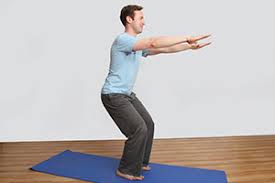
The Chair Pose (Utkatasana) is a standing power yoga pose that tones the entire body, particularly the thighs! .” Its Sanskrit name comes from the words “utkata” (meaning “powerful” or “fierce”) and “asana” (meaning “pose”). It can sometimes be quite a fierce pose for your thighs and it gets your heart pumping quickly. A great addition to our Power Yoga Poses and the weight loss is a massive bonus!
How to do it the Chair Pose-
- Begin with a standing position
- Bend the knees until the thighs are almost parallel to the floor.
- Keep the butt low.
- Raise the arms up towards the ceiling.
- Bring a slight back bend into the upper back s if you are about to sit in a chair.
- Hold 5-10 breaths.
- Repeat 5 times
Benefits of the Chair Pose are:
- Improves circulation in the knee, toe and ankle joints.
- Tones the thigh, lower leg, leg and knee muscles
- Helps strengthen the lower back and torso.
- Balances the body
- Helps with the regular weight loss programmes
- Stretches and exercises the spine, hips and mid section muscles
- Helps to cure slipped disc and lumbago in the lower spine.
- Strengthens and firms upper arms and all muscles of thighs, calves and hips.
5. Boat Pose (Paripurna Navasana)
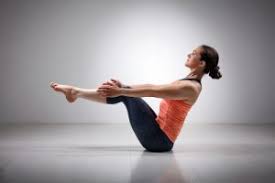
The Boat Pose (Navasana) is derived from the Sanskrit word ‘Nava’, meaning ‘boat’. The moniker for it is “The Boat Pose”, because the posture makes the practitioner resemble a boat. Since this Asana lies in the advanced category, it is seldom utilized to the full extent of its intensity. It’s a great Power Yoga Pose that should be used much more than it actually is.
How to do the Boat Pose-
- Begin seated on the floor with your legs extended out forward
- Place your hands on either side of your torso by your hips, with your fingers pointing forward
- With an elongated spine, engage your core by activating your lower abdominals while focusing on your breath
- Lengthen your body from your hip bones right to the top of your head
- Start to lean back onto your sitting bones (not your tailbone), while keeping a straight neutral spine and lower abdomen slightly engaged
- On an exhale bend both your knees and lift your feet and shins parallel to the mat
- Maintaining your upper body, start to extend your legs, raising the tips of your toes to eye level or above
- Reach the final position by extending your arms parallel to the floor or take them into whatever expression you feel is appropriate for you
Benefits of the Boat Pose are:
- Strengthens your core abdominal muscles
- Aligns the spinal column and tones and strengthens the buttocks, thighs and legs
- Strengthens the adductor muscles of the inner thighs
- Strengthens your spinal muscles, specifically erector spinae, quadratus lumborum, lower trapezius, transversospinalis (the small network of muscles that connect each individual vertebra)
- Helps to prevent back problems and also to rectify existing long-term imbalances
- Cleanses your kidneys and facilitates fresh blood supply, thus ridding your body of toxins.
- Greatly improves concentration and enervates numbness in your mind
- Builds willpower, determination, and self-control
- Seals your energy field and prevents prana from leaking out
- Strengthens your hip flexors, iliopsoas, and quadriceps
- Produces prana flow throughout your body
6. Child’s Pose (Balasana)
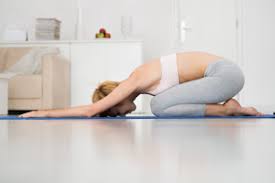
This is another great Power Yoga Pose for beginners and also great for Weight Loss. It’s a stretching exercise that elongates the back, reduces tension between the vertebrae and the discs. Used at the end of a yoga session to warm down and de-stress!
How to do the Child’s Pose-
- Start on all fours with your arms stretched out straight in front of you,
- Sit back so your butt muscles come to rest just above — but not touching — your heels.
- Hold that position for 5 to 10 breaths
- Repeat as many times as needed for a good, soothing stretch.
Benefits of the Child’s Pose are:
- This pose helps soothe headaches as it relaxes upper back and neck.
- Calms the brain and helps relieve stress and fatigue.
- Relieves back and neck pain when done with head and torso supported.
- Great for weight loss when practiced regularly.
7. Mountain Pose (Tadasana)
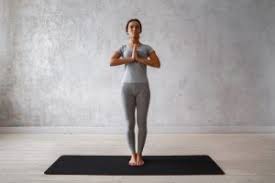
The Mountain Pose (Tadasana), is a basic standing posture and is, therefore, the foundation for all others. Physically, it helps to create space within the body, allowing internal organs to work more efficiently. This can drastically improve respiration as well as digestion and circulation. Mentally, it leaves its users invigorated and motivated, making it perfect for an early A.M. yoga session.
One of the easiest Power Yoga Poses for beginners, this pose features arm variations to help extend breath and center the mind and body.
Some people use a strap to complete arm positioning.
How to do the Mountain Pose-
- Start by stretching your toes and rolling your ankles.
- Stand straight and center your weight on all four corners of your feet.
- As if someone is lifting you up by a string, bring your shoulder blades down into your back.
- Firm the thighs, but do not lock the knees.
- Soften the eyes, and let tension drain from your face.
- Relax the arms at your sides.
- Keep your chest wide, but do not stick your ribs out to breathe. Let the breath flow from your lower abdomen, rising up and out the nose.
Benefits of the Mountain Pose are:
- Improves posture.
- Increases strength, power, and mobility in the feet, legs, and hips.
- Reduces flat feet.
- Increases awareness.
- Steadies breathing.
- Firms abdomen and buttocks.
- Relieves sciatica.
- Strengthens thighs, knees, and ankles.
8. Warrior Pose 1 (Virabhadrasana I)
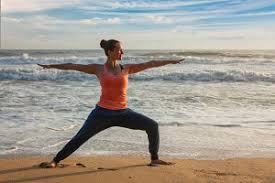
In Hindu mythology, the warrior pose is named after the fierce warrior Virabhadra. This poses helps center your balance, focus and determination. It’s Power Yoga Poses & weight loss all rolled into one, as it strengthens and stretches the thighs, abdomen, calves and back muscles all in one gentle pose!
How to do the Warrior Pose-
- Breathe normally, then inhale and step the right foot forward and bend into the right knee.
- Raise both arms up and lock the fingers together with the index fingers pointing up.
- Keeping the head in between the elbows then arch the back.
- Breathe out bringing the arms to the sides and shift the weight back so that the right knee comes back under the body next to the left knee.
- Hold 20 seconds.
- Repeat 3 times on each side.
Benefits of the Warrior pose are:
- Brings calmness , courage, grace and peace.
- Increases strength in Shoulders, Arms & back
- Tones abdominal muscles
- Relieves lower & upper backaches and also sciatica.
- Increased flexibility of the legs, hips & groin
- Can be beneficial in case of frozen shoulder.
- Improve balances in the body, helps increase stamina.
- Improves balance and stability
- Releases stress in the shoulder very effectively in a short span of time.
- Very beneficial for those with sedentary or desk bound jobs.
9. Bridge pose (Setu Bandha Sarvangasana)
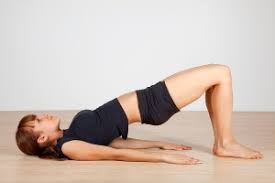
This Power Yoga Asana Pose gets its name from the Sanskrit words ‘Setu’, which means bridge, ‘Bandha’, which means lock, and ‘Asana’, which means pose. This pose resembles the structure of a bridge, and therefore, it is named as such. This pose stretches your back, neck, and chest and relaxes your body.
How to do the Bridge Pose-
- Begin the asana by lying flat on your back.
- Bend your knees and place your feet on the floor hip-width apart. Make sure that your ankles and knees are placed in a straight line.
- Let your arms rest beside your body, with your palms facing downwards.
- Inhale, and lift your back (lower, upper, and middle) off the floor. Roll in your shoulders, and make sure your chin touches your chest without you having to move it. Let your shoulders, feet, and arms support your weight.
- Firm up your buttocks as you tighten them. Make sure your thighs are parallel to each other and the floor.
- Interlace your fingers and push your hands harder to the ground to lift your torso higher.
- Hold the posture for at least a minute. Breathe slowly and deeply.
- Exhale and release the pose.
Benefits of the Bridge Pose are:
- Calms the brain and helps alleviate stress and mild depression
- Stimulates abdominal organs, lungs, and thyroid
- Rejuvenates tired legs
- Stretches the chest, neck, and spine
- Improves digestion
- Helps relieve the symptoms of menopause
- Reduces anxiety, fatigue, backache, headache, and insomnia
- Therapeutic for asthma, high blood pressure, osteoporosis, and sinusitis
- Relieves menstrual discomfort when done supported
10. Corpse Pose (Savasana)
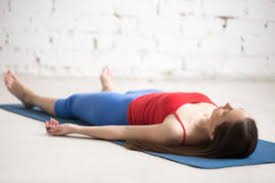
Usually practiced at the end of a long hard session, this reclining posture doesn’t always need props, but some people are more comfortable resting on a bolster with a pillow under the head. Take your time with this one – it’s extremely relaxing. One of the easiest but under-estimated Power Yoga Poses for beginners to undertake!
How to do the Corps Pose-
- Neatly, place a blanket lengthwise along the length of your sticky mat.
- Lie Down on your back and stretch the legs in Supta Tadasana. See that you are in the center of sticky mat.
Adjust the shoulders down your back as you did in Supta Padangustasana. - Allow your two feet to fall apart from one another, relaxing your leg muscles.
- Turn your upper arms from the inside out and place the arms equidistantly about 6 inches away from your body. The palms are turned up towards the ceiling.
- Relax every muscle in your body from the tip of your toes to the top of your head.
- Consciously relax the body and in so doing, quiet the mind and move into a deep relaxation for 15 minutes a day, if possible.
Benefits of the Corpse Pose are:
- Shavasana relaxes your whole body.
- Releases stress, fatigue, depression and tension.
- Improves concentration.
- Cures insomnia.
- Relaxes your muscles.
- Calms the mind and improves mental health.
- Excellent asana for stimulating blood circulation.
- Beneficial for those suffering from neurological problem, asthma, constipation, diabetes, indigestion.
- This posture brings a deep, meditative state of rest, which may help in the repair of tissues and cells, and in releasing stress. It also gives time for the yoga workout to sink in at a deeper level.
- This posture leaves you in a state of rejuvenation. It is the perfect way to end a yoga session, particularly if it has been a fast-paced one.
- It helps reduce blood pressure, anxiety, and insomnia.
- This is an excellent way to ground the body and reduce the Vata dosha(imbalance of the air element) in the body.
